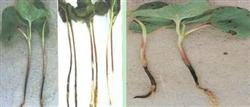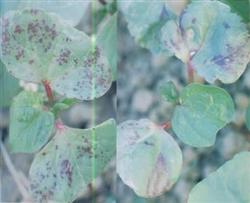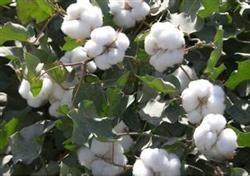Why does cotton have rotten roots?

Cotton may have anthracnose, symptoms: cottonseed can be damaged after germination and rot in the soil. The injured light, can also be unearthed, the seedling stem base produced purplish red stripes, and then expanded into a fusiform disease spot, slightly sunken, serious water loss vertical crack, and finally withered the seedlings. The masses call it rotting root disease. The disease spots on the cotyledons are mostly on the edge of the leaves, semicircular, round in the leaves, grayish brown, and reddish brown on the outside. The disease spot on the bell begins to be very small, red-purple, and then expands and becomes black and sunken. When it is wet and overcast, the disease spot produces reddish-brown sticky material, which is the spore of the pathogen, called conidia. Diseased bells often rot or form stiff flaps. Leaves, stems and flowers are also occasionally infected. Disease regularity: the pathogen lives in the remaining stems, leaves and rotten bolls in seeds and cotton fields, invades the seedlings after sowing, produces conidia, and then spreads infection. When cotton bolls were damaged in the later stage, the pathogen could invade the inside of the seed. After sowing, the disease of low temperature overcast and rainy seedlings was serious, and it was rainy before flower harvest, and the boll disease increased. Prevention and control methods: (1) strengthen the prevention and control measures of agriculture, improve the quality of sowing, and level the land before sowing. It is required to sow seeds at the right time, and the sowing depth is 3.5 to 5cm, so as to avoid being too deep and too shallow. Appropriate early seedling, timely pest control, diligent ploughing, deep ploughing, combined with the application of fast-acting fertilizer, reduce soil moisture, increase soil temperature and cultivate strong seedlings. (2) select cottonseeds and dry them more than half a month before sowing. In the northern cotton area, soak the seeds in 55-60 ℃ warm soup for 30 minutes, turn them 2-3 times during soaking, and then soak the seeds at room temperature until they absorb enough water. (3) Cotton seeds were treated with chemicals. Seed dressing with pentachloronitrobenzene, rice foot green and mixed seed ling + thiram can treat both blight and red rot, or seed dressing with pentachloronitrobenzene + carbendazim, pentachloronitrobenzene + thiram (or anthrax) can treat both blight and red rot.
- Prev

Prevention and Control of bacterial Corner spot in Cotton
First, agricultural measures. 1. Fine soil preparation, application of sufficient fertilizer, irrigation of soil moisture, and selection of disease-resistant varieties. 2. Reasonable crop rotation and deep winter irrigation to promote the decomposition of diseased and disabled bodies. 3. Strengthen mid-tillage at seedling stage, reduce soil moisture, apply less nitrogen fertilizer, increase phosphorus and potassium fertilizer, and cultivate strong seedlings. 4. Strengthen the management of cotton fields and drain water in time after rain.
- Next

Key measures for management of cotton boll opening period
During the boll opening period, high-yield cotton looks precocious and does not senescence prematurely, which requires boll opening in the lower part of the plant, continued flowering in the upper part, and few late buds. The robust growth of cotton, the top fruit branch flat extension, fruit branch length of 20 cm 30 cm, there are 3 buds 4. If the top fruit branch stretches up too long, buds grow, and flowers break too late, it is prosperous and greedy at night.
Related
- The first cup of black tea in spring, the flavor and history of tea gardens in Kenya, Africa
- The computer can not only choose potatoes, but also grow tea rice. AI will grow winter oolong tea champion.
- It is not only the inflated tea bitten by insects, but also engraved with the four seasons tea in Beipu.
- The Oriental Beauty Tea Festival in Zhuxian County takes the stage at the weekend to experience the plus-size feast of oil tea.
- & quot; Oriental Beauty Tea & Exploration of Emei in Hsinchu, the hometown of quot;
- The new variety of strawberry "Tainong 1" dessert is the first choice with mellow aroma. Crimson gorgeous
- History of Tea in Taiwan: from Wild Inner Mountain to Export Tea Garden
- Two types of Taiwan Oriental Beauty Black Tea won the British three-Star Award for Childhood Tea Xiang Zhang Jiaqi changed from pilot to champion tea maker.
- Banana species and varieties: the planting history of Taiwan Xianren banana and dwarf banana is long, is banana disease resistant?
- Coffee planting Technology: Qianjie Coffee from Seedling to harvesting

